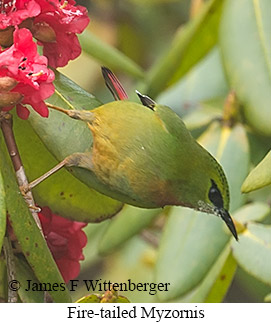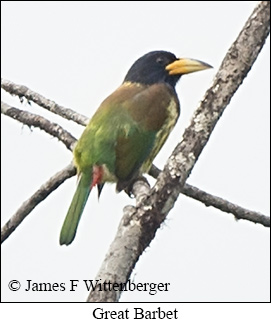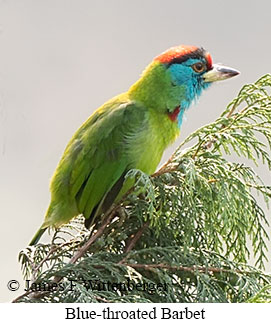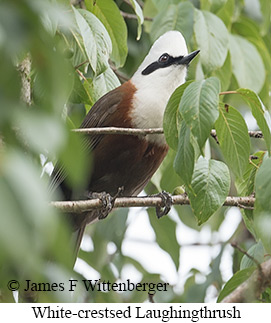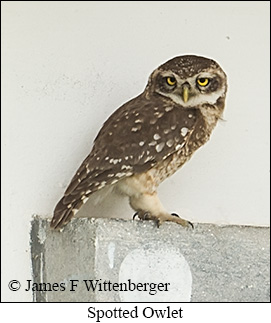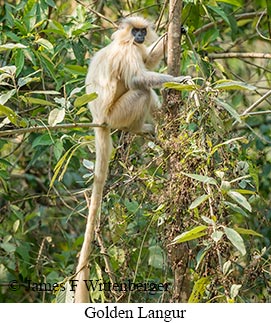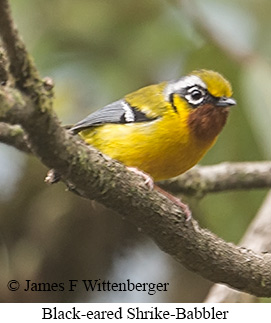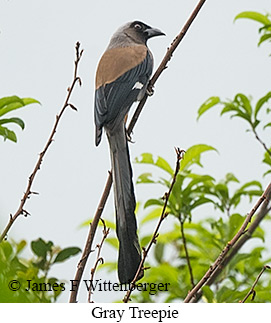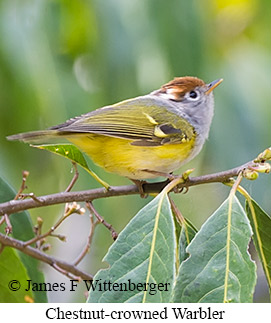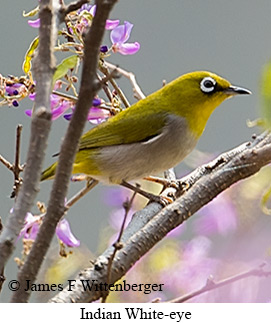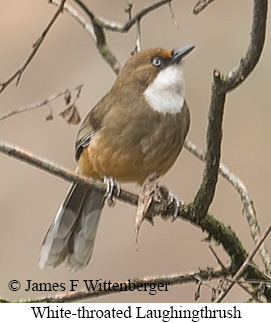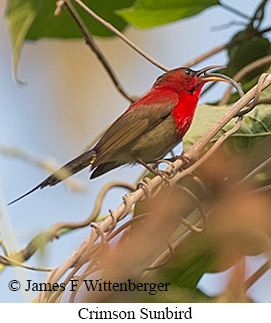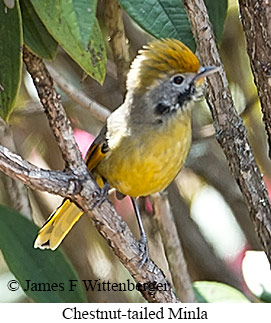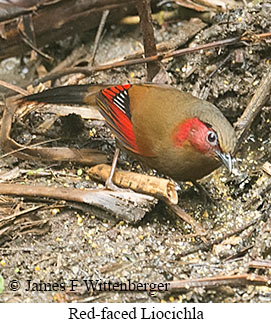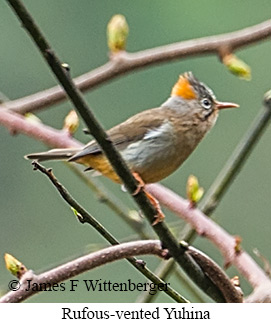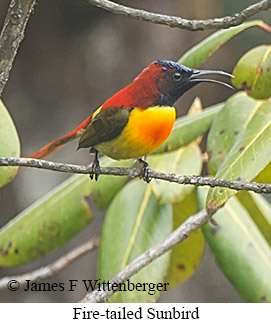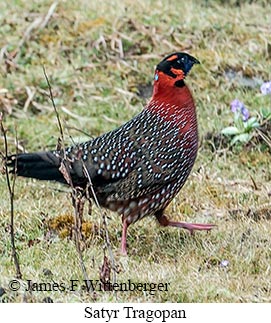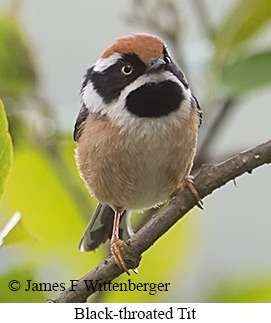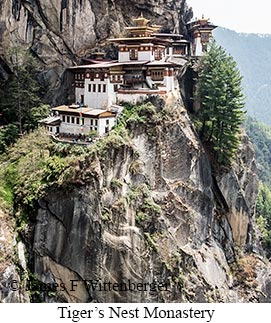BHUTAN BIRDING TRIP REPORT

TRIP REPORT
BHUTAN
| Start: | 04/05/2024 |
| End: | 04/24/2024 |
| Duration: | 20 days |
| #Species: | 322 |
| #Endemics: | 1 |
| #Heard Only: | 17 |
2024 Birding and cultural tour to Bhutan.
TOUR DESCRIPTION
Bhutan is a mountainous country offering some of the best birding in Asia. The mountains of western Bhutan are covered in coniferous forests, while the mountains in the east are covered with deciduous oak forest. The mountains are the foothills of the Himalayan range. The slopes are steep with deep, V-shaped valleys carved by raging rivers. Roads are narrow but now mostly two lanes and paved with asphalt, often high above the valleys below, perched on ledges or cliff faces, sometimes with guard rails along the outer edges, sometimes not. In addition to birding, Bhutan offers a rich cultural experience and fascinating history. It would be remiss to ignore that aspect of the country and we did not.
To travel in Bhutan it's necessary to operate in conjunction with a Bhutanese tour operator. Our tour was organized by one of the foremost birders in Bhutan, Hishey Damphu. Hishey was one of the first expert birders in Bhutan and trained many of the others who now lead tours there. He is also intimately involved in conservation efforts to protect the critically endangered White-bellied Heron . He is also the manager of the Thimphu Football Club as well as the national team. In addition, a second guide, Chhimi Rinzin, also an expert birding guide, accompanied us on the tour. In addition to birding, Chhimi often guides cultural tours in Bhutan during non-birding seasons and is very knowledgeable about Bhutan's culture and history. He was a great addition to our overall experience. We traveled in a very comfortable minibus, a Toyota Odessey, during the tour. This was a privately organized tour with 4 participants plus myself.
The tour began with our arrival at the Paro international airport, the only international airport in Bhutan and, at the time of our tour, the only port of entry open to North Americans, as the land port of entry at Samdrup Jonkhar was closed to foreigners other than Indians. The approach into the Paro airport is a little bit dicey, as the plane must navigate through a river valley with high hills on either side. I was in a window seat and saw the plane at one point skimming over an outcropping ridge seemingly just a few hundred feet below. We arrived on a clear day and the snow-capped Himalayan range was visible in the distance.
Upon our arrival at 8:00am from Bangkok, we were met at the airport and headed for the capital city of Thimphu. Not far from the airport we stopped along a fast-flowing river where we saw two adult Ibisbills along with 4 young chicks. This species is so different that it merits an avian family, Ibidorhynchidae, all its own. After spending some time viewing and photographing this species, we drove to Thimphu along a mountainous but well-traveled road, about an hour's drive away. That afternoon we visited the School of Arts and Crafts in Thimphu. The school is devoted to training the most talented artists in the 13 traditional art forms in Bhutan including painting on canvas and silk, sculpture, wood carving, metal working, engraving, weaving, and more. We were all enthralled by the incredible talent of the students enrolled in the school. From there we visited the Post Office Museum where the walls are papered with extraordinary patterns created by beautiful Bhutanese stamps. Everyone was fascinated by the stamp collections on display there. After that, we went to the textile museum and were amazed by the intricate patterns woven into cotton and silk cloth. The museum is considered to be the best in Bhutan and features stunning examples of ancient and contemporary textiles. Displays exemplified the best traditions of Bhutanese weaving and embroidery including the wedding clothes of the fourth king and the various styles of local dress. Although our tour was focused on birding, we were all thrilled to have this exposure to the cultural side of Bhutan.
Next morning we departed early for nearby Jigme Dorji National Park. The road climbs steeply up into the foothills of the Himalayan range. Mountain slopes are covered in dense Oak forest lower down and Blue Pine higher up. We spent the whole morning birding roadsides in the park. Our primary target bird was the stunning Satyr Tragopan, which we finally found. We had rather brief views of two males in poor light but hoped to see it again later in the tour. Other birds we saw this morning included Darjeeling Woodpecker, Yellow-billed Blue-Magpie, Green-backed Tit, Lemon-rumped Warbler, Rufous-vented Yuhina, Black-faced Laughingthrush, Chestnut-crowned Laughingthrush, Hoary-throated Barwing, Spotted Laughingthrush, Gray-winged Blackbird, White-collared Blackbird, Mrs. Gould's Sunbird, and Red-headed Bullfinch. After returning to Thimphu for lunch, we visited an archery competition taking place that afternoon. Archery was once the way the overall ruler of the 5 different fiefdoms of Bhutan was decided before the unified kingdom was established in 1907. The archers used simple bows (as opposed to compound bows) to shoot arrows at a small target located 145 meters away. Each time an archer actually hit the target, the team formed a circle and chanted in celebration. This was a friendly contest so everyone was having a good time. From there we visited the giant Buddha statue on a hillside overlooking the valley outside the city.
On day 3, April 7 we departed for the city of Punakha. First stop was Dochu La (La means pass) at an elevation of 3100m (10,170ft) where a memorial site is located. The 108 stupas or chortens were built to honor the Bhutanese soldiers killed in a December 2003 battle with insurgents from Assam. In addition, a larger temple was built in 2008 to celebrate 100 years of the Bhutanese monarchy. We birded a short trail above the stupas where we saw our main target species, Fire-tailed Myzornis along with Gray-backed Shrike, Large-billed Crow, Common Rosefinch, and Dark-rumped Rosefinch. We then continued downslope toward Punakha, stopping along the way at several sites for birding and at a nice restaurant for lunch. At Lampeli Botanical Gardens we added Besra, Rufous-bellied Woodpecker, Eurasian Jay, Asny-throated Warbler, Chestnut-crowned Warbler, Chestnut-crowned Laughingthrush, White-throated Laughingthrush, and White-browed Bush-Robin. A Hill Partridge flushed while we were walking the trails, seen by a few. Farther downslope we did some roadside birding around the MenChhuna Restaurant, where we had lunch. There we picked up Green-backed Tit, Gray-hooded Warbler, Black-faced Warbler, Hodgson's Treecreeper, Ultramarine Flycatcher, and Fire-breasted Flowerpecker. After reaching the valley, we added Eurasian Hoopoe and Long-tailed Shrike.That afternoon we visited the Punakha Dzong, a fascinating place used as a monastery where monks reside during winter months, featuring large statues of the current king, prior king, and Buddha along with numerous smaller statues of Buddha and extraordinary murals depicting the life and later traditions of Buddha. During our visit some two dozen monks were carrying on a traditional prayer session with chanting and blowing of Tibetan horns.
On day 4 we departed at 5:30am for Damphu, also known as Damphu. En route we had views of the original Punakha Dzong, located outside the current city on a hillside commanding the Punatsange Chhu (River) where the original dzong was constructed in 1637 as a seat of government and defense against invaders from Tibet. Birds seen in the valley included several species of ducks, and shorebirds along with Crested Kingfisher, White-capped Redstart, Hodgson's Redstart, White-browed Wagtail, and White Wagtail. We continued south along the Wang Chhu, birding several sites along the way. Notable birds seen included Green-billed Malkoha, House Swift, Indian Roller, Great Barbet, Blue-throated Barbet, Bar-winged Flycatcher-Shrike, Gray Treepie, Black-throated Prinia, Indian White-eye, Chestnut-tailed Starling, Spot-winged Starling, Blue Rock-Thrush, and Crested Bunting.We stopped at an overlook high above the river where a pair of the critically endangered White-bellied Heron was known to have nested. Only 27 individuals of this species remain in Bhutan, with the remainder found in remote parts of northeastern India and nearby Myanmar. We spent an hour scanning the river far below in hopes of seeing the species, and finally Chhimi somehow spotted one among the rocks on the far bank of the river. Another individual was spotted briefly as it flew down the river. We had very good views with our spotting scope. We were so far away that it was difficult to see the bird with our binoculars. From there we continued south to the White-bellied Heron Conservation Center where 3 previously injured adults are maintained in enclosures. The hope is that they can produce some chicks, as nesting success of pairs in the wild is very low due to nest depredations by monkeys. After some time at the center, we continued on to Damphu with some birding stops en route where we saw Spotted Dove, White-throated Kingfisher, Short-billed Minivet, Orange-headed Thrush, and Golden-fronted Leafbird.
On April 9, day 5, we began the day checking out the parking area in front of the hotel where we had very good views of White-crested Laughingthrush and also Tickell's Leaf Warbler and Yellow-bellied Warbler. After breakfast, we drove up to higher elevation above Damphu. Our drive upslope produced Striated Bulbul, Black-throated Tit, Gray-crowned Tit, Silver-eared Mesia, Chestnut-bellied Rock-Thrush, and Blue-capped Rock-Thrush. A few of us had brief views of a Red-billed Leiothrix from the bus window. Farther upslope we saw a Black Eagle in flight along with Long-tailed Minivet, Gray-hooded Warbler, Whiskered Yuhina, Striated Laughingthrush, our only sighting of Bhutan aughingthrush, and Blue-winged Minla . After reaching the top of the pass, we continued downhill toward Gelephu. While still at higher elevation we picked up Great Barbet, White-throated Fantail, Gray-hooded Warbler, Brownish-flanked Bush Warbler, Himalayan Cutia, Rufous Sibia, Rusty-fronted Barwing, and Rufous-bellied Niltava. Shortly before lunch we encountered a big flock of many White-naped Yuhinas along with Scarlet Minivet, Yellow-bellied Warbler, and White-tailed Nuthatch, the first of many Yuhina-based flocks we saw during the tour. We also had great views of Golden-throated Barbet in the same area. During our lunch stop we saw several Himalayan Swiftlets overhead. As we continued downslope after lunch we soon spotted several Beautiful Nuthatches, an often difficult bird to see that we were thrilled to pick up. Farther along, we soon added Maroon Oriole, Large Woodshrike, Black-naped Monarch, the stunning Sultan Tit, Black-crested Bulbul, and Dark-sided Flycatcher. We also had great views of a perched Crested Serpent-Eagle. We reached the lowlands outside Gelephu about 3:00pm. This area is near the border with India so we had to stop and show our visas at a military checkpoint before continuing on. Birding is a bit difficult as there is heavy traffic along the road, making stopping difficult, and heavy construction of expanded airport facilities and a new, wider road was underway. Even so we did see Indian Peafowl and Indian Roller before reaching our hotel.
We spent all of day 6 birding around Gelephu. We quickly picked up Jungle Babbler along the road and then drove to the sewage ponds where we birded a wetland area outside the gate and then walked a path along the edge of the ponds. Birds we saw included Lesser Whistling-Duck, Asian Koel, Himalayan Swiftlet, White-breasted Waterhen, Red-wattled Lapwing, Indian Pond-Heron, Black Drongo, Rufous Treepie, Great Myna, Siberian Stonechat, and Citrine Wagtail along with some shorebirds. Our guide saw 3 Wreathed Hornbills fly by behind our backs while we were walking, missed by everybody else. On our way back to the hotel for breakfast we saw the striking Indian Pied Starling. Shortly after breakfast, a severe thunderstorm with heavy rainfall began. We later learned that golf-ball sized hail hit the Damphu area where we had been the previous day as part of this storm, causing damage to many vehicles there. We waited out the storm until the sun came out about 10:00am before going out birding again. Outside Gelephu we picked up Oriental Honey-buzzard Black Kite, Spotted Owlet, White-throated Kingfisher, Indian Pied Starling, Great Myna, and White-browed Wagtail before returning for lunch. Another storm came through after lunch with strong winds, thunder, and rain. After the storm dissipated, we did some birding late afternoon back toward the sewage ponds and nearby, picking up Indian Peafowl, Greater Racket-tailed Drongo, Red-breasted Parakeet, Gray Treepie, and Great Myna. We also saw our first Golden Langur, which is found only in southern Bhutan and neighboring Assam in India, though in poor light.
We left Gelephu on day 7 for the drive to Tingtibi. We soon left the lowlands, with the road winding uphill into foothills. It was very windy. We soon saw a troop of Rhesus Macaques along the road. We also had brief views of Wreathed Hornbill, good views of White-throated Bulbul, and mostly backlit views of Great Barbet, Common Green-Magpie, White-throated Bulbul, Long-tailed Sibia, and Streaked Spiderhunter. We stopped at a hot springs lodge for breakfast where we saw Crested Serpent-Eagle and Black Eagle soaring above. After breakfast we stopped for birding several times. We had great views of a male and small group of female and young Golden Langurs along with a nice view of a stunning Black Giant Squirrel. Birds we picked up included Himalayan Cuckoo, Blyth's Swift, Rufous-necked Hornbill, Fulvous-breasted Woodpecker, Long-tailed Broadbill, Gray Treepie, and Sultan Tit. Following a picnic lunch we continued on toward Tingtibi. We soon reached a rock face where a large active honeycomb of bees was suspended above. There we had good scope views of Yellow-rumped Honeyguide. As we continued driving, we soon encountered a troop of Assam Macaques and our only sighting of Orange-bellied Himalayan Squirrel along with Blue-bearded Bee-eater, Green-backed Tit, Gray-hooded Warbler, and Blue-winged Minla. Around 4:00pm we encountered a large mixed flock, one of many seen during the tour. Species in the flock included a Black-eared Shrike-Babbler plus Green-backed Tit, Gray-cheeked Warbler, Green-crowned Warbler, Whiskered Yuhina, Golden Babbler, Rufous-winged Fulvetta, Blue-winged Minla. We spent quite a while checking out the flock before eventually continuing on to Tingtibi, arriving there at 6:00pm. The hotel in Tingtibi was comfortable enough but a bit more basic than most other places we stayed during the tour.
On April 12, day 8, we left the hotel at 6:00am, birding the higher elevation area above Tingtibi, where we saw another group of Golden Langurs as well as Asian Barred Owlet, Rufous-necked Hornbill, Sultan Tit, Yellow-vented Warbler, Rufous-necked Laughingthrush, Orange-headed Thrush, Dark-sided Flycatcher, Streaked Spiderhunter, and a female Orange-bellied Leafbird. While stopped for breakfast we had great views of a perched Mountain Hawk-Eagle. Several birding stops at lower elevation below Tingtibi after breakfast produced Common Cuckoo, Gray-headed Woodpecker, Gray-chinned Minivet, Bronzed Drongo, Gray Treepie, Green-backed Tit, Blyth's Leaf Warbler, Black-throated Tit, Nepal Fulvetta, White-tailed Nuthatch, Small Niltava, Pale Blue Flycatcher, Black-throated Sunbird, And Red-headed Bullfinch. We heard Red-headed Trogon late in the morning but could never lure it into the open for a sighting of it. We returned to our hotel for lunch. After lunch, we birded an area outside Tingtibi, picking up Pin-tailed Green-Pigeon, Fulvous-breasted Woodpecker, Greater Yellownape, and Crimson Sunbird. Later that afternoon we added Pale-billed Parrotbill followed by Chestnut-headed Bee-eater, Yellow-throated Bulbul, Striated Yuhina, Indian White-eye, and two Great Hornbills in flight.
Day 9 we did some early birding outside Tingtibi, picking up Rufous-necked Hornbill, Wreathed Hornbill, Greater Yellownape, Gray Treepie, Sultan Tit, Black-crested Bulbul, Rufous-faced Warbler, Black-chinned Yuhina, Indian White-eye, Silver-eared Mesia, Red-tailed Minla, Lesser Necklaced Laughingthrush, Chestnut-bellied Nuthatch, Large Niltava, Small Niltava, Rufous-bellied Niltava, Blue-throated Flycatcher, Black-throated Sunbird, and Orange-bellied Leafbird among others. A few people saw Bay Woodpecker fly across the road. After breakfast back at the hotel, we departed for Panbang to the southeast, driving through the vast Royal Manas National Park en route. At various birding stops we had mostly good views of Fork-tailed Drongo-Cuckoo, Wreathed Hornbill, Great Barbet, Golden-throated Barbet, Blue-throated Barbet, Ashy Drongo, Yellow-vented Warbler, great views of White-hooded Babbler, Chestnut-tailed Starling, and Dark-sided Flycatcher. At the bridge over the Tongasa Chhu we had great views of a perched Collared Falconet and more distant views of Brown Dipper. We stopped for an early afternoon picnic lunch along the road. That afternoon we stopped several times for birding. Species seen included Great Hornbill, Common Green-Magpie, Black-crested Bulbul, Red-whiskered Bulbul, Common Hill Myna, Great Myna, Asian Fairy-bluebird, and Golden-fronted Leafbird. A few people saw Barred Buttonquail scurry across the road, missed by me. We also saw a group of Capped Langurs during the drive.
April 14, day 10, began with some birding around our hotel in Panbang. Among the many species seen there were Green-billed Malkoha, Asian Barred Owlet, Great Barbet, Lineated Barbet, Blue-throated Barbet, Lesser Yellownape, Common Iora, Black-naped Monarch, Sultan Tit, Common Tailorbird, Chestnut-crowned Warbler, Indian White-eye, Chestnut-bellied Nuthatch, and Taiga Flycatcher. After breakfast at the hotel, we departed at 8:30am for Nganglam., located in the lowlands near the border with India. Birding stops en route yielded Mountain Imperial-Pigeon,Eurasian Crag-Martin, Red-rumped Swallow, and Black Bulbul. A few of us briefly saw a Spotted Forktail along a fast-moving stream before it flew. It was a sunny day so bird activity was pretty low. We stopped for lunch at a Buddhist-style Chorten (Stupa). After lunch we checked another fast-moving mountain creek where we saw Slaty-backed Forktail. We also had good views of wild Red Junglefowl along the road, distinguished from domestic roosters by their gray legs.
We spent early morning after breakfast of day 11 birding outside Nganglam. We quickly saw a group of Jungle Mynas in flight. Then we attracted a large flock of birds that included Bronzed Drongo, Hair-crested Drongo, Great Barbet, Blue-throated Barbet, Gray Treepie, Sultan Tit, Common Tailorbird, Black Bulbul, Black-crested Bulbul, Black-chinned Yuhina, Indian White-eye, Rufous Sibia, Lesser Necklaced Laughingthrush, White-crested Laughingthrush, Long-tailed Shrike, Chestnut-tailed Starling, Crimson Sunbird, and Streaked Spiderhunter responding to our playback of Collared Owlet. Other birds we saw near Nganglam included Ashy Drongo, Long-tailed Shrike, Red-vented Bulbul, and Taiga Flycatcher. We also saw a Crested Serpent-Eagle perched in a tree off the road. After that, we began the drive northward along the relatively new road linking Nganglam to Yongko La. En route we stopped at a river bridge where we saw Slaty-backed Forktail again along with Crested Kingfisher, White-capped Redstart, and Scaly-breasted Munia. However, our main target bird, Blyth's Kingfisher didn't seem to be present. We spent awhile waiting in hopes of seeing it, and finally it appeared. Later in the morning we saw another Capped Langur along the road. We also saw another Black Giant-Squirrel along with a Himalayan Striped Squirrel. We arrived in the town of Yongko La in time for late lunch.
The forests in the highlands above Yongko La town are considered to offer the best birding in Asia, and we devoted the next several days birding that area. For a first introduction, the afternoon of day 11 we birded along the road at higher elevation above our hotel, where we saw Blyth's Swift, Black-eared Shrike-Babbler, Yellow-browed Tit, Lemon-rumped Warbler, Blyth's Leaf Warbler, Whiskered Yuhina, Chestnut-tailed Nuthatch, Blue Rock-Thrush. We had prolonged views of Himalayan Cutia higher up. Late in the afternoon we had scope views of Yellow-rumped Honeyguide followed by good views of Yellow-cheeked Tit.
The morning of day 12 we visited the site where Ward's Trogon is usually seen. A birding group from India we encountered at the hotel had spent the previous 4 days looking for the trogon without ever seeing it, and our success was no better. Even so, birding was very good. Early on we saw Black-eared Shrike-Babbler, Gray-cheeked Warbler, Blyth's Leaf Warbler, Black-faced Warbler, Golden Babbler, and White-throated Laughingthrush. We had a picnic breakfast in the field and that was followed by more birding. First up was White-throated Fantail, Green-backed Tit, Yellow-cheeked Tit, Chestnut-bellied Rock-Thrush, White-throated Laughingthrush, and Green-tailed Sunbird followed later that morning by views of Gray-cheeked Warbler, Golden-breasted Fulvetta, Blue-winged Minla, Chestnut-tailed Minla, Rusty-fronted Barwing, Mrs. Gould's Sunbird, and Gold-naped Finch. At mid-day we saw a flock of Golden-throated Barbet, Gray-chinned Minivet, Black-faced Warbler, Yellow-throated Fulvetta, and Blue-winged Minla followed by another flock that included Gray-chinned Minivet, Yellow-cheeked Tit, White-naped Yuhina, Whiskered Yuhina, and Golden Babbler. The birds were extremely active, responding to our owl playback, so we were kept busy for some time trying to see everything. We returned to our hotel for lunch at 1:15pm and went back out an hour later. By that time the weather was a bit misty. We drove down to the river where we soon found a pair of Brown Dippers. We also saw White-capped Redstart and Gray Wagtail. We continued birding along a trail near the river where we hoped to see Tawny Fish-Owl at a knowm roosting site. We found two of them there for good views. Other birds we saw along the trail included Fork-tailed Drongo-Cuckoo, Green-backed Tit, Black Bulbul, Yellow-vented Warbler, Chestnut-bellied Nuthatch, Verditer Flycatcher, Crimson Sunbird, and Orange-bellied Leafbird. We also saw two Himalyan Bulbuls, a very localized species in Bhutan best seen at this site. Late in the afternoon we added Large Hawk-Cuckloo and Gray Bushchat.
We left the hotel at 6:00am on day 13 and soon encountered rain so we returned to the hotel an hour later to wait it out. After the rain stopped about 8:00am, we left the hotel once again and drove upslope. We soon encountered a flock of Scarlet Finches that flew over the road and perched in a treetop before continuing down into the valley. That was followed by good views of Gray-headed Canary-Flycatcher and after that a flock of many Gray-cheeked Warblers plus Gray-chinned Minivet, Blyth's Leaf Warbler, and Black-faced Warbler. Still farther up the road we heard Ward's Trogon calling and after 20 minutes or so of looking for it and trying to lure it in with playback, we had great views of a male that flew into a tree near the road and perched in plain view. It wasn't long before we were surrounded by a busload of curious German tourists who wanted views of it through our scope. After the bird flew, we continued up the road and encountered another birding group who also saw Ward's Trogon, though only the female. By this time some fog had arrived, making birding more difficult. Even so, we picked up Slender-billed Scimitar-Babbler and Chestnut-tailed Minla before we stopped for a picnic lunch where the road crossed a fast moving stream with a big waterfall both higher up and below the road. Some people in the group picked up Little Forktail there but I wasn't near them and missed it. The fog was in and out after lunch but wasn't really much of a problem though the gray skies weren't great for photography. Birding farther up the road after lunch offered up Large Hawk-Cuckoo, Yellow-browed Tit, Ashy-throated Warbler, Stripe-throated Yuhina, and Chestnut-tailed Minla. Around 3:30 we encountered a mixed flock consisting of Chestnut-headed Tesia, Whiskered Yuhina, Stripe-throated Yuhina, Rufous-vented Yuhina. Black-chinned Yuhina, Rufous-winged Fulvetta, White-throated Laughingthrush, Rufous-gorgeted Flycatcher, Chestnut-bellied Rock-Thrush, and Green-tailed Sunbird. Not long after that we had good views of Striated Yuhina, Black-chinned Yuhina, Hoary-throated Barwing, and Mrs. Gould's Sunbird along with a Black Eagle in flight. This was followed by good views of a female Satyr Tragopan along the road and then a Himalayan Cuckoo. On our way back downslope toward the hotel we stopped again at the waterfall, and I was able to see Little Forktail that I missed earlier. We also saw White-capped Redstart at the river and many Nepal House-Martins nesting on nearby cliffs.
The weather was improved the morning day 14. We drove to a nearby private residence where the owner puts out some dried rice for the birds. We soon saw Gray Treepies there followed by Red-faced Liocichla. A couple other species that normally show up there didn't, but we saw those elsewhere a bit later. Other birds along the side road past this residence offered additional species, including Golden-throated Barbet, Lesser Racket-tailed Drongo, Black Bulbul, Nepal Fulvetta, Striated Laughingthrush, White-crested Laughingthrush, Rufous-necked Laughingthrush, Verditer Flycatcher, and Orange-bellied Leafbird. We also saw a Gray-throated Babbler in dense understory though not at all well. After breakfast back at the hotel, we drove upslope a short way to look for some more secretive birds. We had brief views of Blue-winged Laughingthrush in dense vegetation. With some effort we eventually had very good views of Rusty-fronted Barwing and fairly good though brief views of Coral-billed Scimitar-Babbler. We tried hard for a singing Sikkim Wedge-billed Wren-Babbler, which was finally seen by a couple people in our group after a lot of looking. Fog returned by mid-day, and we had rather washed out views of a Large Hawk-Cuckoo through the fog in a treetop. We returned to our hotel for lunch at 12:45pm and shortly thereafter, the rain was with us once more. We waited it out until 3:00pm when the rain finally stopped. We drove back up the road and soon saw Green-backed Tit, Common Tailorbird, Black-throated Prinia, Tickell's Leaf Warbler, Rusty-cheeked Scimitar-Babbler, and Rufous-necked Laughingthrush. We also saw another Yuhina flock but no new species in it. Late in the afternoon on our way back downslope we had brief views of Rufous Accentor followed by scope views of Little Bunting.
On day 15 we departed our hotel at 7:00am to begin the transfer to Chhumey. We didn't get very far before we encountered a big flock that included many Red-tailed Minlas along with Himalayan Cutia, Rufous Sibia, Blue-winged Minla, Fire-breasted Flowerpecker, Black-throated Sunbird, and a single Scarlet Finch. This was followed by good views if two mpore male Scarlet Finches and then another flock consisting of Long-tailed Minivet, Striated Bulbul, Rufous-vented Yuhina, Chestnut-tailed Minla, and Green-tailed Sunbird. While hanging out there checking out the flock, I had very close views of a Slender-billed Scimitar-Babbler along the road not far from where our minibus was parked. In the sane general area we had good views of Striated Bulbul, Blue-winged Minla, and Red-tailed Minla. We continued driving up toward the pass, and en route some people in the group saw two male Satyr Tragopans along with a female before they disappeared into thick understory. By late morning we reached the pass and the highlands near Sengor. We soon encountered a late migrating Asian Brown Flycatcher followed by Red-billed Chough. Not long after that we encountered Stripe-throated Yuhina and then Golden Bush-Robin and White-collared Blackbird. A bit farther along we found a big flock consisting of Gray-crested Tit, Buff-barred Warbler, Rufous-vented Yuhina, Chestnut-tailed Minla, Blue-fronted Redstart, and Green-tailed Sunbird. We stopped for lunch in the field near Sengor at an elevation of 10,500ft. After lunch we continued driving a fairly short distance before seeing another birding group along the road. They had seen a Red Panda just off the road. By the time we arrived, the panda was gone, not to be seen again. We had missed seeing it by just a few minutes. From there we continued up to a higher pass where we stopped for more birding. There we had really great views of two target species, Fire-tailed Myzornis and Fire-tailed Sunbird. A bit farther still we saw the spectacular Blood Pheasant along the road followed by good views of Alpine Accentor. The day was not done yet. At 4:55pm we saw a male Satyr Tragopan for a good photo opportunity and, an hour later, decent views of Himalayan Monal. We finally reached our hotel in Chhumey shortly before 7:00pm.
On April 20, day 16, we departed at 6:55am after breakfast. The day was bright and sunny, so birding was a bit slow. We did have good views of Black-faced Laughingthrush along with several species seen many times previously. Around 9:10 we encountered a big flock consisting of Coal Tit, Rufous-vented Tit, Gray-crested Tit, Rufous-vented Yuhina, Chestnut-tailed Minla, Green-tailed Sunbird, and Dark-rumped Rosefinch. This was followed by Eurasian Hoopoe, Long-tailed Minivet, and Blythe's Leaf-Warbler. The highlight of the morning was our sighting of a rare Black-headed Shrike-Babbler. Shortly before reaching the picturesque town of Trongsa, which is situated on a steep hillside above a deep river valley, some of us saw an Indian Muntjac along the road before it disappeared into the understory. We reached Trongsa in time for lunch. From there we continued on to Phobjikha Valley, a largely agricultural area. Many Red-billed Choughs were feeding in the highlands en route to the valley, along with many domesticated Yaks. The valley is best known as the wintering area of over 700 Black-necked Cranes, absent by the time we were there. We did visit the Black-necked Crane Center in the valley. In late afternoon we saw 3 Himalayan Griffons soaring very high and very far from our hotel.
We departed next morning about 5:30am, heading back up to higher elevation to Pele La. On our way we picked up a couple Oriental Skylarks along the road. At Pele La we birded a relatively flat dirt road off the main highway. This area was incredibly scenic with many red, pink, and yellow Rhododendrons in bloom covering the hillsides. It's a good place to see Himalayan Monal and we eventually did see one, mostly fairly far away, though Hishey flushed the bird trying to get a photo, causing it to fly directly over my head and then downslope where it perched in a tree some distance away. We saw many other birds in this area including Speckled Wood-Pigeon, Himalayan Griffon, Himalayan Buzzard, Rufous-bellied Woodpecker, Long-tailed Minivet, Eurasian Nutcracker, Red-billed Chough, Yellow-bellied Fairy-Fantail, Gray-crested Tit, Green-backed Tit, Whistler's Warbler, Rufous-vented Yuhina, Black-faced Laughingthrush, Hoary-throated Barwing, White-collared Blackbird, Dark-sided Flycatcher, Rufous-gorgeted Flycatcher, Green-tailed Sunbird, Rufous-breasted Accentor, Rosy Pipit, White-winged Grosbeak, Red-headed Bullfinch, and Crimson-breasted Finch. We returned to the pass at 9:50am, where we stopped to take photos of the stufa there. Fron Pele La we drove westward to the town of Nubding, arriving about 11:00am. Beyond Nubding we had good views of White-throated Laughingthrush followed by a female Ward's Trogon. After lunch, we continued driving westward. We encountered a big flock at 2:30pm, consisting of Gray-chinned Minivet, Whiskered Yuhina, Blue-winged Minla, White-tailed Nuthatch, Ultramarine Flycatcher, Fire-breasted Flowerpecker, Mrs. Gould's Sunbird, and Chestnut-capped Warbler. This was followed by a soaring Mountain Hawk-Eagle, and thereafter by another big flock of Gray-chinned Minivet, Green-backed Tit, Green-crowned Warbler, Blyth's Leaf Warbler, Black-throated Tit, and Gray-crowned Tit. We reached Dochu La at 4:15pm and continued on past Thimphu to Paro, arriving there at 6:15pm.
We devoted April 22 to hiking up the trail to Tiger's Nest Monastery. Two of my four participants did the hike, while the other two declined and stayed in Paro. The hike is quite substantial, with a 900m (nearly 3000ft) elevation gain. There is a cafe quite far up the mountain toward the monastery, which is as far as one can reach by hiring a horse to go up the trail. From there, a substantial further uphill hike leads to an observation area overlooking the monastery. From the overlook, one must go down about 700 steps into a gorge and then back up 600 steps on the other side to reach the monastery. My two participants did that part of the trail and toured the monastery itself. I was slower going up so didn't go any further than a viewing area about 100 steps down from the overlook. It was not an especially easy hike, as it is almost continuously uphill to the overlook. Even so, it was well worth doing. Many people visit the monastery, perhaps most as tourists but also some on pilgrimage to pay their respects, pray, and leave offerings. After hiking back down the trail, we had time to visit the Rinpung Dzong. One cannot go inside, but we walked the trail around the outer walls.
On the morning of our last full day of the tour we drove up to Chele La. On clear days one can see higher peaks of the Himalaya on the border between Bhutan and Tibet. Along the road we encountered a Kalij Pheasant followed by two Satyr Tragopans. We saw several Blood Pheasants, these with much less red on them than the ones seen earlier in the highlands above Yongko La. A few people saw a Eurasian Woodcock that scurried across the road in front of our minibus. Along the road we also had good views of Spotted Nutcracker and Whistler's Warbler. We ate a picnic breakfast at the top of the pass While there was had brief views of Himalayan Monal and distant views of White-winged Grosbeak. After breakfast we drove back down the pass, stopping a couple times for some birding without seeing much of anything. We reached our hotel at 11:30 and had lunch there. On our way back to Paro, some participants saw a Himalayan Bluetail. That afternoon we visited the National Museum, housed in the ancient Ta-dzong building in Paro. The museum houses numerous masterpieces of Bhutanese art covering 1500 years of Bhutan's heritage. We then went to a previously reliable spot to look for the scarce and secretive Black-tailed Crake. No luck. We then went to a second spot and again no luck. Finally, at the third site we tried and after considerable patience, we had good views of a crake as it briefly came into the open.
We departed Bhutan the morning of April 24 via flight from Paro to Bangkok with a stopover in Daca, Bangladesh. En route to the airport in Paro, we stopped to see how the Ibisbills were doing The female and two, now larger, chicks were present. Everyone considered the tour a great success, with wonderful birding as well as a memorable visit to several important cultural sites in Bhutan.
BIRDING LOCALES

